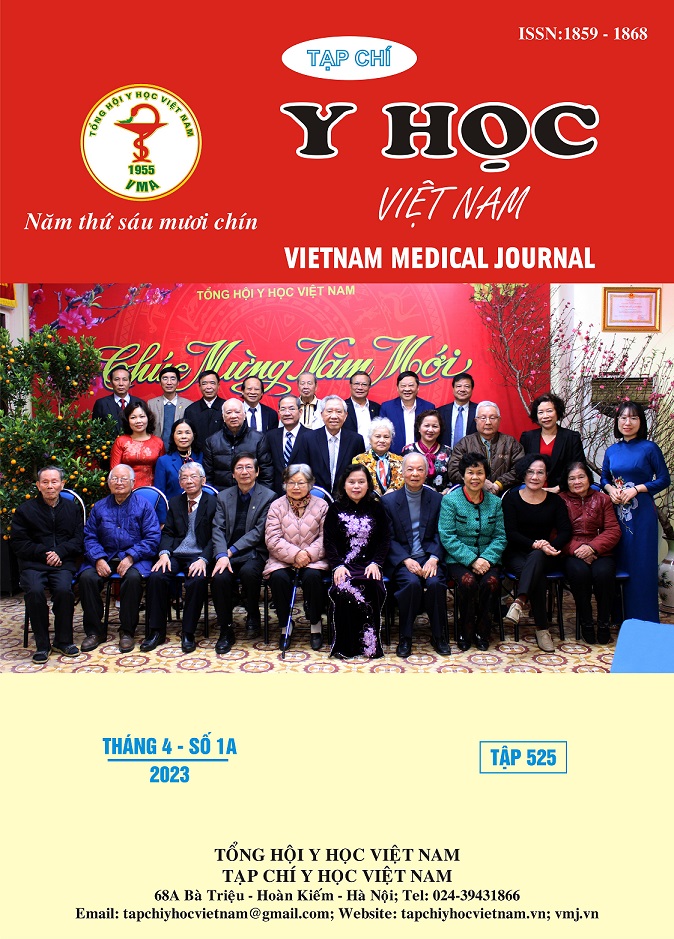SUSCECCFUL ONE-STAGE SURGICAL TREATMENT FOR ADULT PATIENT WITH MULTI VAVLE DISEASE AND COARCTATION THROUGH MIDDLE STERNOTOMY AT THE VIET DUC UNIVERSITY HOSPITAL
Main Article Content
Abstract
Purpose: Report a complex case with multi-valve disease and coarctation in adult patient, who underwent successful one-stage surgical treatment through mild sternotomy. Patient and method: This is a retrospective descriptive report a complex case. Result: The forty-two-year-old man was admitted to our hospital with diagnosis: arterial hypertension, server aortic valve regurgitation, mild mitral valve and tricuspid valve regurgitation, dilatation of ascending aorta and coarctation. On 11/05/2022 patient underwent surgery for aortic valve replacement, repair of mitral and tricuspid valve, ascending to descending aortic bypass, using 16mm Darcron graft through mild sternotomy. The patient was extubated after 6 hours and discharged from the hospital after 10 days of surgery without complications. Postoperative echocardiography and CT scan show good function of valves and no gradient on coarctation. Conclusion: Extra anatomic ascending to descending aortic bypass simplifies operative process and it may perform through only mild sternotomy.
Article Details
Keywords
Coarctation, multi-valve disease, Viet Duc university hospital
References
2. Baumgartner H, Bonhoeffer P, De Groot NMS, et al. ESC Guidelines for the management of grown-up congenital heart disease (new version 2010). Eur Heart J. 2010; 31(23) :2915-2957. doi: 10.1093/eurheartj/ehq249
3. Jurcut R, Daraban A, Lorber A, et al. R. Coarctation of the aorta in adults: what is the best treatment? Case report and literature review. J Med Life. 2011;4(2):189-195.
4. Velayudhan BV, Idhrees AM. R. Coarctation of aorta in adults: a narrative review of surgical and endovascular management. Journal of Visualized Surgery. 2021;7(0). doi:10.21037/jovs-19-196
5. Thurber J. R. Ascending-To-Descending Aortic Bypass For Coarctation of the Aorta. Published online May 30, 2022. Accessed May 30, 2022. https://www.ctsnet.org/article/ascending-descending-aortic-bypass-coarctation-aorta
6. Alkashkari W, Albugami S, Hijazi ZM. R. Management of Coarctation of The Aorta in Adult Patients: State of The Art. Korean Circ J. 2019;49(4):298-313. doi:10.4070/kcj.2018.0433
7. Connolly HM, Schaff HV, Izhar U, Dearani JA, Warnes CA, Orszulak TA. R. Posterior Pericardial Ascending-to-Descending Aortic Bypass. Circulation. 2001;104(suppl_1):I-133. doi:10.1161/circ.104.suppl_1.I-133
8. Said SM, Burkhart HM, Dearani JA, Connolly HM, Schaff HV. R. Ascending-to-descending aortic bypass: a simple solution to a complex problem. Ann Thorac Surg. 2014;97(6):2041-2047; discussion 2047-2048. doi: 10.1016/j.athoracsur.2014.02.030
9. McKellar SH, Schaff HV, Dearani JA, et al. Intermediate-term results of ascending–descending posterior pericardial bypass of complex aortic coarctation. The Journal of Thoracic and Cardiovascular Surgery. 2007;133(6):1504-1509. doi:10.1016/j.jtcvs.2006.11.011


